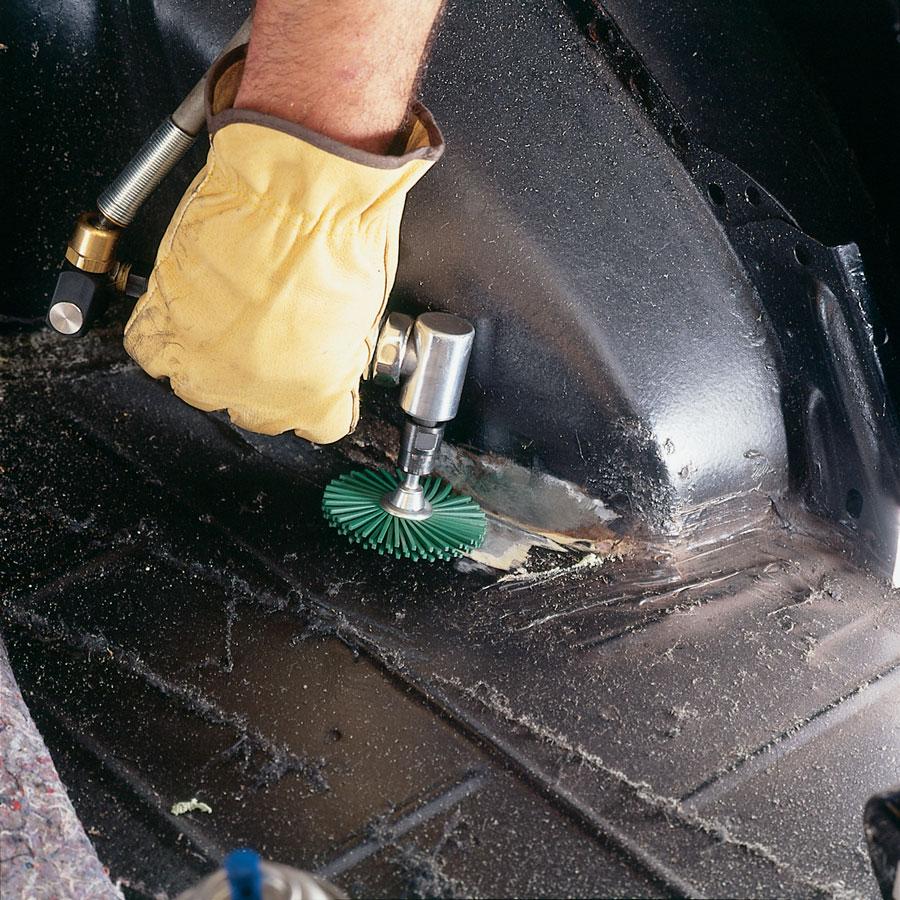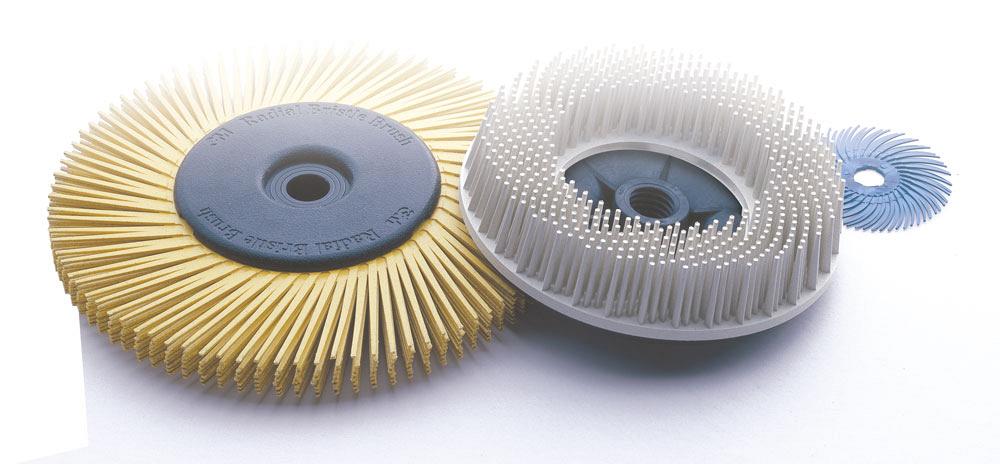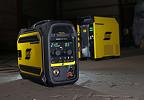Editor
- FMA
- The Fabricator
- FABTECH
- Canadian Metalworking
Reaching a delicate finish
Nylon-based bristle products can serve as an alternative to wire brushes and other abrasives when the ultimate finish is important
- By Rob Colman
- January 22, 2018
- Article
- Metal Finishing

Nylon-based bristle products can serve as an alternative to wire brushes and other abrasives. Its conformability is a particularly useful attribute when working in hard-to-reach areas of a weldment. Images courtesy of 3M Canada.
When you usually think about abrasive products, it’s the physical toughness of those products as much as anything else that comes to mind; the solidity of a wire wheel or the surface roughness of an abrasive disc demonstrates to the user that this material is going to work through material quickly and efficiently. But occasionally a job calls for a more delicate touch, either because you don’t want to damage the substrate, or simply because the part that requires burr or paint removal is an awkward shape that a wire or disc can’t reach.
That’s when a nylon-based bristle brush can step in as an alternative. While still capable of removing material efficiently, the flexibility of the nylon substrate allows the product to reach where other discs can’t. 3M’s Scotch-Brite™ bristle discs and brushes have a nylon substrate impregnated with the company’s Cubitron™ ceramic mineral, so while the toughness is still at the core of the tool, it moves over and around material differently.
“This nylon-based product can displace wire wheels in a number of applications,” said Joe Veit, account executive in the abrasive systems division at 3M. “It will deburr, polish, and clean welds, and it can do so either on an angle grinder or a bench motor. For certain heavy applications, like very large burrs caused in plasma cutting or very heavy scale, you really can’t replace a wire wheel, but in many other, more delicate applications, a bristle disc or brush makes a lot of sense.”
Veit also noted that for safety considerations, the bristle discs and brushes stand out from both wire wheels and abrasive discs.
“The nature of the design of the product means that not only is the base structural material flexible, but the concentration of the grit isn’t the same as it is on an abrasive disc,” he said. “So in comparison with a wire wheel, for instance, you don’t have to be concerned with the product flipping up and hitting the user the way wire can. Safety is a big reason that we encourage users to consider these products compared to wire.”
Because these bristle products aren’t as widely used as typical abrasives, initially an operator may not know what to expect from a 120- or 80-grit bristle disc.
“Although those grit varieties will be well-known to users, an 80-grit bristle is going to act differently than an 80-grit abrasive disc,” said Veit. “For that reason, we distinguish each different bristle grade with a colour. In fact, we’ve created what could be called a starter pack for users so that they have an opportunity to understand how each grade works in practice. It also includes a surface conditioning disc.”
Because conformability is another attribute of this nylon-based product, the bristle brushes are available in a curved form. This shape improves the product’s ability to get into hard-to-reach spaces, be it a narrow part of a weld on a trailer or rust on the thread of a tool.
Using the brushes and discs can require adjustment. Veit counselled users to “just let it do its work. Don’t apply too much pressure because we are not asking it to go deep into the part. It’s not wire, so there’s no need to lean into it at all. When using an angle grinder, just put it on a slight angle as you would with any abrasive.”
One of the most effective applications of the product is the removal of paint when you want to carefully maintain the substrate.

Although the grit varieties of these bristle products will be well-known to users, an 80-grit bristle is going to act differently than an 80-grit abrasive disc. For that reason, the grits are distinguished from each other by colour.
“This allows you to clear away that paint without chemicals,” said Veit. “Again, from a safety standpoint this is an advantage. And you’re left with a surface that is ready to be repainted.”
Bristle discs and brushes can’t replace all the abrasives you use on your shop floor but for detail work, light deburring, and paint removal, they are niche products that have proven their effectiveness. The question becomes, Can it match or exceed the performance of the abrasive or wire I’m using now? And how does the safety profile of each product match up?
Editor Robert Colman can be reached at rcolman@canadianfabweld.com.
3M Canada, www.3mcanada.ca
About the Author

Rob Colman
1154 Warden Avenue
Toronto, M1R 0A1 Canada
905-235-0471
Robert Colman has worked as a writer and editor for more than 25 years, covering the needs of a variety of trades. He has been dedicated to the metalworking industry for the past 13 years, serving as editor for Metalworking Production & Purchasing (MP&P) and, since January 2016, the editor of Canadian Fabricating & Welding. He graduated with a B.A. degree from McGill University and a Master’s degree from UBC.
subscribe now


Keep up to date with the latest news, events, and technology for all things metal from our pair of monthly magazines written specifically for Canadian manufacturers!
Start Your Free Subscription- Trending Articles
CWB Group launches full-cycle assessment and training program

Achieving success with mechanized plasma cutting

3D laser tube cutting system available in 3, 4, or 5 kW

Brushless copper tubing cutter adjusts to ODs up to 2-1/8 in.

Welding system features four advanced MIG/MAG WeldModes

- Industry Events
MME Winnipeg
- April 30, 2024
- Winnipeg, ON Canada
CTMA Economic Uncertainty: Helping You Navigate Windsor Seminar
- April 30, 2024
- Windsor, ON Canada
CTMA Economic Uncertainty: Helping You Navigate Kitchener Seminar
- May 2, 2024
- Kitchener, ON Canada
Automate 2024
- May 6 - 9, 2024
- Chicago, IL
ANCA Open House
- May 7 - 8, 2024
- Wixom, MI















